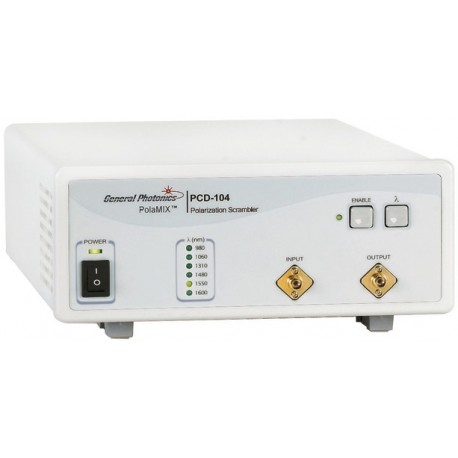Polarization Scrambler

Reference number: GPC-PCD-104
Polarization Scrambler PCD-104 PolaMix?


Reference number: GPC-PCD-104
Polarization Scrambler PCD-104 PolaMix?

Besoin de plus d'informations ?
Contactez notre expert.
Notre équipe
Description
Ce brouilleur de polarisation utilise une conception technologique tout fibre (all-fiber) afin de de randomiser (scrambler) efficacement les états de polarisation. La dépolarisation par brouillage de polarisation a de nombreuses applications. Le brouillage de polarisation du signal d?entrée peut éviter les incertitudes de mesure provoquées par la sensibilité dépendante de la polarisation du matériel d´essai. La dégradation des performances due à le gain dépendant de polarisation (PDG) induite dans les amplificateurs optiques peut être supprimée par le brouillage de l´état de polarisation (SOP). En complément, le brouillage de polarisation peut également être utilisé dans des systèmes pour faciliter et simplifier la surveillance de la PMD. Basé sur une technologie brevetée du tout-fibre, le PCD-104 offre des performances supérieures avec une faible perte d´insertion (insertion loss) et de perte par réflexion (return loss), et une très faible phase résiduelle et la modulation d´amplitude.
| Insertion Loss | <0.05dB (without connectors) <0.6 dB (with connectors) |
| Center Operating Wavelength¹ | Remote or manual selection of 980 nm, 1060 nm, 1310 nm, 1480 nm, 1550 nm, 1600 nm |
| Operating Wavelength Range2 | >100 nm |
| Output Degree of Polarization(DOP)3, 4 | <5 % |
| Average PMD | <0.05 ps |
| Intrinsic PDL | <0.05 dB |
| Return Loss | >65 dB (without connectors) |
| Optical Power Handling | >1000 mW |
| Residual Amplitude Modulation | < ± 0.01 dB |
| Residual Phase Modulation | < 0.1 ? |
| Power Supply5 | 100 ~ 120 VAC, 50-60 Hz or 200 ~ 240 VAC, 50 - 60 Hz |
| Power Consumption | 12 W typical |
| Scrambling Frequencies4 | Factory set 4 fixed frequencies, distributed between DC and > 700 kHz3 |
| Communication Interfaces | RS-232, Ethernet, GPIB |
| Operating Temperature | 10 ~ 45 °C |
| Storage Temperature | -10 ~ 50 °C |
| Dimensions | 2U, 19" half rack width, 3.5" × 8.5" × 14." (H × W × L) |
Downloads